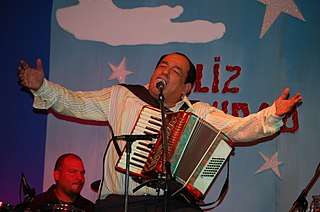Carlos Mejía Godoy

Carlos Mejía Godoy (born June 27, 1943) is a Nicaraguan musician, composer and singer. He was born in Somoto, Madriz. Son of Carlos Mejía Fajardo and María Elsa Godoy, his brother Luis Enrique Mejía Godoy, three years younger than he is, is also an acclaimed and much-loved musician. Carlos and Luis Enrique were pivotal in the New Song Movement in Central America beginning in the 1970s. They were both recently honored with Nicaragua's highest cultural distinction, the Order of Rubén Darío.
Biography
Carlos started his career as 'Corporito' on the radio station 'Radio Corporacion', where he would daily compose songs that would rain ridicule and scorn on all politicians and political parties. He would do it with that biting sense of humor that so few artists are able to master.
Many of his songs, performed with his band los de Palacagüina, became associated with the Sandinista movement as songs of the workers and revolutionaries. He even composed a Mass for the working class, the Misa Campesina Nicaragüense. Many of his songs during the late 1970s gave instructions on how to use, assemble, and disassemble the rifles people were capturing from dictator Somoza's National Guard during street battles.[1][2][3][4][5]
One of his biggest achievements of his career as a songwriter came in 1977, when the song "Quincho Barrilete" (Quincho, the boy of the little barrel), composed by himself and performed by Eduardo Gonzalez won the sixth edition of the OTI Festival. A victory which is still remembered by many Nicaraguans.
In 1980, Carlos Mejía Godoy y los de Palancagüina were internally selected by Televicentro Nicaragua to represent their country in the OTI Festival in 1980 with their song "La chavalita de España" (The little girl from Spain). This song marked the return of Nicaragua to the event after two years of absence because of the turbulent Nicaraguan Revolution. Their competing song, which although was one of the favourites, ended in a respectable but disappointing tenth place with 15 points.
He was the vice-presidential running mate of Edmundo Jarquín of the Sandinista Renovation Movement (MRS) in the November 2006 presidential election. They came in fourth place.
Mejía Godoy is the father of the United States Army deserter and author Camilo Mejía, as well as the musicians Carlos Luis 'La Bujilla' Mejía and Augusto 'El Negro' Mejía from the Grammy-nominated Nicaraguan ensemble La Cuneta Son Machín[6][7].
Discography
- Albums
Some of his albums include: El Son Nuestro De Cada Día, La Nueva Milpa, Grandes Éxitos, and A Dos Puyas, No Hay Toro Valiente.
- Contributing artist
His music has been featured on several compilations of songs of Nicaragua and the Nicaraguan revolution: Songs of the Nicaraguan Revolution, Vol.1-2, and Nicaraguita: Music from Nicaragua. He was also featured in The Rough Guide to the Music of Central America (2002, World Music Network). Mejía Godoy was featured on the title track from La Cuneta Son Machín's Cañambuco (2017, Round Whirled Records).
Jefferson Starship recorded one of his songs for their 2008 album Jefferson's Tree of Liberty
References
- ↑ "Guitarra Armada". Guitarra Armada. archive.org. Retrieved 6 September 2010.
- ↑ Belli, Gioconda (2002). The Country Under My Skin. Alfred A. Knopf. p. 229. ISBN 978-0-375-40370-5.
- ↑ "Disco| Guitara Armada (Guitar Armed)". Al Sur de Rio Bravo. Archived from the original on 21 August 2010. Retrieved 6 September 2010.
- ↑ Plunkett, Hazel (2007). Nicaragua in Focus: A Guide to the People, Politics and Culture. Interlink Publishing Group, Inc. pp. 82–83. ISBN 1-56656-438-7.
- ↑ Sheperd, John (2003). Continuum Encyclopedia of Popular Music of the World: Media, industry and society. Continuum International Publishing Group. p. 390.
- ↑ Bennett, Sarah (11 February 2016). "La Cuneta Son Machín Are Proud to Be Nicaragua's First Grammy-Nominated Band". LA Weekly. Retrieved 12 February 2018.
- ↑ Eparaza Loera, Juan (3 February 2018). "Mezcla de música tradicional con lo nuevo resulta en éxito para La Cuneta Son Machín". Vida en el valle. Retrieved 12 February 2018.